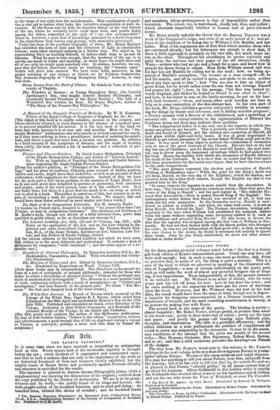Sift 1,rto.
THE BAYEUX TAPESTRY.° IT is some time since we have received so interesting an antiquarian hook as this. Every square inch of the invaluable tapestry is brought before the eye ; every incident of it expounded and commented upon; and that in such a manner that not only is the importance of the work as an historical document of facts and manners clearly exhibited, but the mighty tussle of Saxon thews and pertinacity against Norman chivalry and resource is revivified for the reader.
The tapestry is printed in sixteen chromo-lithographic plates, (with a supplementary one showing the dimensions of the original,) reduced from the copy published by the Society of Antiquaries. We see it in its primi- tiveness and its truth,—the gawky forms of its kings and heroes; the well-caught action of its mounted warriors, and its dead and dying ; its tasselled trees, twisted like skeins of worsted ; and its bordered beasts
• The Bayeux Tapestry Elucidated: by Reverend John Collingwood Bruce, LL.D., F.S.A., Corresponding Member of the Society of Antiquaries of Scotland, ace. Published by 1, B, Smith,
and monsters, whose grotesqueness is that of impossibility rather than invention. The colour, too, is reproduced, chiefly red, blue, and yellow ; which alternate impartially whether in human hair or parti-coloured horses.
Mr. Bruce stoutly upholds the theory that the Bayeux Tapestry was a work of the Conqueror's reign, and even of an early period of it ; and ad- heres to the tradition of its being due to William's wife Matilda and Iser ladies. Most of his arguments are of that kind which satisfies those who are convinced already ; but his inferences are enough to show that, if there is little approach to certainty on his own side, not much more ex- ists on the other. Throughout his elucidation he quotes copiously and aptly from the nervous and racy pages of the old chroniclers, chiefly Wace,—writers who had an eye and a heart for a man, and knew how tti present his figure living to others. How Duke William wooed and won his fair but coy Matilda by rolling her in the mud ; how, on being ap- prized of Harold's coronation, "be became as a man enraged—oft he tied his mantle, and oft he untied it again, and spoke to no man, neither dared any man speak to him"; how "the sea was to him an object of great dread, but he would rather cross the sea than not revenge himself and pursue his right"; how, in his passage, "his face was turned to- wards England, and thither he looked as though he was about to shoot"; and how, in his hurry to arm on the battle-morning, he put on his hau- berk back foremost ;—these, and many other such touches, are here to help us to some conception of the dim-distant fact. In his own part of the book, Mr. Bruce exhibits a genuine antiquary's fertility in account- ing for things by theory and inference and in finding minutia) pregnant ; a literary manner with a flavour of the oldfashioned, and a sprinkling of sarcastic salt. An extract relative to the representation of Edward the Confessor dying and dead may indicate these qualities. "The compartment before us is the only one in the tapestry in which two scenes are given in one breadth. This is probably not without design. Tho death and burial of Edward, and the election and coronation of Harold, all took place within eight-and-forty hours. It was of great importance to Harold to get actual porometrion of the crown before William (Auld put in his claim. It was usual in these times to perform the ceremonies of coronation only at one of the great festivals of the Church. Edward died on the last day but one of Christmas; and for Harold to wait till Easter, the next festi- val, was to throw away the important advantage which he had gained over his riveL Hence the rapidity with which the coronation of Harold followed the death of the Confessor. It is to show that no sooner had the vital spirit fled than preparations for the burial were begun, that we have the two scenes in the same compartment. "The next pictures represent the election and coronation of Harold. William of Malmesbury says—' While the grief for the King's death was yet fresh,. Harold, on the very day of the Epiphany, seized the diadem, and extorted from the nobles their consent, though the English say that it was granted him by the King.' "In many respects the tapestry is more candid than the chroniclers. It here says, 'Jib DEDERUNT SlAROLDO CORONAM REOIES—Here they gave the crown of the King to Harold ' ; and the next legend is, ReanDwr HA- ROLD Rax ANOLOIttIM,—Heee is seated Harold King of the English.' Ono contemporary writer denies that Harold was anointed at all, or had any claim but his own usurpation. In the Doomsday survey, Harold is men- tioned as seldom as possible ; and when his name does occur, it is not as King Harold, but Harold the Earl. The Norman chroniclers, writing sub- sequently to the time when William had established his conquest, seldom write his name without appending some derogatory epithet to it, such as the perfidious and perjured King Harold.' All this seems to favour the idea that the tapestry was designed during the first visit of William to Nor- mandy. He had not then broken faith with the Saxon nobles who thronged his court ; he was not yet independent of their good-will ; so that, in stating his own claims to the crown, he found it necessary not entirely to ignore their views. After he was firmly established, ho cared not what women stitched or clerks wrote."


































 Previous page
Previous page